2 ¿De dónde viene tu comida?
Objetivos de Aprendizaje
Después de las actividades los estudiantes podrán…
- Leer y conocer los eventos sobre el chicano/a/x movement y analizar palabras claves para poder conjugarlas.
- Conocer y reflexionar sobre la importancia que tienen los trabajadores de campo.
- Identificar frutas y conectarlas con su debido campo de en donde las crecen.
- Analizar una canción de Strawberry Fields Forever para poder conocer los tipos de trabajadores de campo y su importancia.
- Analizar anuncios en periódicos digitales para conocer sobre las maneras que hablaban antes para contratar a gente.
- Diseñar su propio anuncio para ver la diferencia entre vocabulario que usarían ahorita.
- Diseñar su propio collage para después identificar las diferentes maneras que se dicen ciertas comidas.
Contexto de Enseñanza
Las actividades de este capítulo fueron creadas para ampliar el conocimiento sobre el movimiento chicano/a/x y para que estudiantes de herencia y de L2 puedan aprender de donde viene su comida. Para este curso, el enfoque será en los estudiantes de nivel intermedio en la universidad. Incluso, estas lecciones pueden ser modificadas de diferentes maneras para otros niveles si gustarían. La clase será compuesta por estudiantes de herencia al igual que estudiantes de L2, ya que hay estudiantes que, aunque no tengan raíces hispanas les interesa aprender sobre diferentes culturas. En este curso, habrá estudiantes con diferentes raíces hispanas, por ejemplo, con raíces de México, Perú, Colombia, Honduras, etc. Para poder hacer estas lecciones, seria ideal tener entre 15 a 20 estudiantes para poder darle esa atención a los estudiantes, pero a la misma vez tener una clase de buen tamaño para que los estudiantes puedan conversar sobre las actividades. El propósito de este capitulo es para que los estudiantes, que ya vienen con ideas sobre el español, puedan obtener nueva información y tener una nueva perspectiva sobre el lenguaje de español y lo que realmente podemos obtener con solo un lenguaje.
For our particular chapter, we wanted to focus on the farm workers that started the Chicano/a/x movement and how they are the ones who provide us with food every day. Their hard work should not go unrecognized. By deciding to tie recipes with the Chicano Movement, we are giving homage to these workers and just how hard they work. Our student population is SHL students. Our ideal level to use our chapter with would intermediate high school and even university, if adjusted. One of our objectives for this chapter is to allow the student to take their learning into their own hands. We recognize the importance of seeing someone you can relate to, in your schoolwork. By doing this with the incorporation of cultural recipes and the movement, we are letting the student learn and share their identity. We want for the student to discover their history is also U.S. History.
Our assignments consist of analyzing a song, conjugating verbs to fill in the blank, creating an announcement for their ideal worker, etc. We wanted to give the student to practice conjugating, writing in Spanish and English, and to just have with their assignment, we do not want them to be bored when completing these.
Marco Teórico
Al crear este capítulo, se pensaron en ideas sobre el libro, “Enseñanza del español y juventud latina” por María Luisa Parra Velasco. En específico, incorporamos esa idea que habla sobre el español y como no solo existe el termino spanglish, pero también términos como “frañol”, “itañol”, “potuñol”, etc., en donde podemos ver que el español se mixtea con otros diferentes lenguajes y culturas (Parra, 45). Es importante que los estudiantes vean el espacio de esta clase como un lugar seguro en donde puedan compartir sus ideas en español, spanglish, o como se sientan a gusto y puedan. La idea es que expresen sus ideas y conozcan el español y lo que trae.
Por lo tanto, también incluimos, “How to tame a wild tongue” por Gloria Anzaldúa, quien nos habla sobre su experiencia siendo una chicana y nos comenta sobre esa opresión que tenía la comunidad chicana dado acabo por las expectativas que tenía la sociedad. Intentamos que los estudiantes se sientan cómodos para evitar esa cita que dice Anzaldúa que le decía que era, “En boca cerrada no entran moscas.” (Anzaldua, 358). Buscamos abrirles las puertas a los estudiantes de herencia al igual que darles el conocimiento a los estudiantes de L2 para que entiendan las injusticias que han pasado gente por el español y como las cosas van cambiando para motivarlos a usar ese lenguaje que por tanto tiempo se ha tratado de olvidar.
Cuando pensamos en esta lección, también incluimos ideas sobre el video de, “Can You Find Your Identity Through A Heritage-Language?” por Susan Poulin, ya que habla sobre su experiencia con su lenguaje que venia siendo French en este caso en vez de español y habla sobre como se le fue olvidando y sobre las injusticias que ellos también tenían cuando empezaron con la ley de que solo se hablara el inglés. Es importante incluir estas ideas en las lecciones ya que los estudiantes pueden ver como gente que habla otros idiomas minoritarios también pueden saber que han sentido estos estudiantes de herencia al igual que sus familias. Este objetivo que tenemos para la clase será que los estudiantes puedan usar su lengua sin miedo y saber que no están solos.
For our theoretical framework, we wanted to start with an introduction to the Chicano Movement. A lot of people do not actually know what the Chicano Movement is because it is not taught in schools. Chicano/a/xs were facing a lot of discrimination in the 1960s and even before then but the 1960s was when the movement took off. It originally started with the UFW, fighting for farmworkers rights because at the time, they were working in unfit conditions. The movement began to evolve more than just farmworker’s rights, we started to see a fight against land ownership, educational rights, and equality.
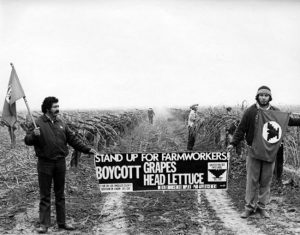
Seccion 1: ¿Qué es el Movimiento Chicano/a/x?
En esta sección hablaremos sobre cómo empezó el Movimiento Chicano/a/x, los líderes, y por qué luchaban.
The Chicano Movement took place in the 1960s when Cesar Chavez and Dolores Huerta started their boycott originally through the National Farmworkers Association (NFWA), what we now know as the United Farm Workers (UFW) Union. The union was mainly composed of Mexican migrants and Filipino migrants. While the Chicano Movement originally started with the UFW, the movement evolved to also focus on land ownership, educational rights, and equality. Cesar Chavez and Dolores Huerta themselves concentrated on worker protection, immigration reform, and pesticides. Farm workers were working in unfit conditions such as working for .$90/hour, no portable restrooms, etc. At this time, the average life expectancy for farmworkers was 49 years of age. They would go on strike, boycott, and protest until their demands were met. During this time, Chicano Spanish also emerged. Chicano Spanish started as a way for Chicano/a/xs to identify as one. A language that truly felt like their own. It consists of terms that is not español ni inglés, but rather both. It is a living language.
Actividad 1.1 Vocabulario del Movimiento Chicano/a/x
Seccion 2 – La Comida y sus raices
Actividad 2.1 – Recetas
Students will be able to cook, bake or create any Chicano recipe they desire. Chicano Eats is a website created by Esteban Castillo, a Gradute Student from South California that was inspired to create and share a little bit of his culture through food. 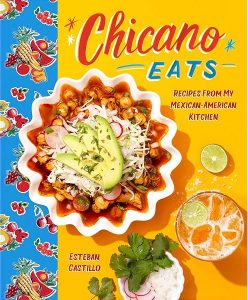 Step 1: Student will visit website and explore the different recipes provided.
Step 1: Student will visit website and explore the different recipes provided.
Step 2: Student will watch You tube videos or take the cooking classes if student wants to to help create a Chicano meal.
Step 3: Create your Chicano food and write a short summary about the food you created and something you found interesting about it. (100 words and include your photo of the dish)
https://chicanoeats.com/
Actividad 2.2 – Anuncio de periódico
Para esta actividad, van a leer dos anuncios de periódicos sobre solicitud de trabajos. Pongan atención a las palabras que se usaban antes para contratar a la gente.
Step 1: Read the following newspaper ads.
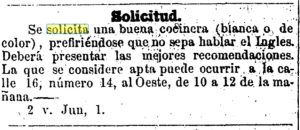
Eco de Cuba (published as EL ECO DE CUBA) (New York, New York)July 20, 1855
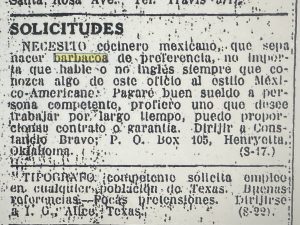
Prensa (published as LA PRENSA) (San Antonio, Texas) August 16, 1916
Pay close attention to the word choices during these times as well as the cities they were published in. Keep in mind how things have changed from that time to today.
Step 2:
Click the following link: https://infoweb-newsbank-com.libweb.lib.utsa.edu/apps/readex/welcome?p=EANASP
Visit some newspapers to see what type of advertisements you can find.
Some possible key words to use: “Solicitud”, “Solicita”, “Se busca”, etc.
Step 3:
Después de ver los ejemplos de solicitudes en periódicos, tu trabajo será crear tu propio anuncio de solicitud de trabajo. El anuncio debe de ser creado por medio de Instagram o Twitter (X) ya que los dos tienen un limite de palabras. Deben de ser directos, pero en su anuncio tienen que mencionar que tipo de trabajo es, si hay preferencia de genero y lenguaje, requisitos que tiene que tener la persona, y por último como se llama el restaurante. Cuando terminen, entregaran screenshot de su anuncio.
Recuerden, deben ser creativos y tratar de usar palabras claves que observaban en otros periódicos.
Actividad 2.3 – Collage de comida
Para esta actividad, estarán creando un collage sobre comida y platos que son populares en su cultura y su familia. Esto es importante para que puedan buscar comidas de su cultura y aprender más sobre eso al igual que puedan hablar más con sus familias y tal vez conocer platos de los que no sabían.
Step 1:
Do some research about popular foods eaten in your culture as well as dishes your family makes that relate to your culture. Mientras hacen su busqueda, tengan esta pregunta presente: Why is this plate/food important in my culture?
Step 2:
Van a crear un collage sobre la comida que piensan que es importante en su cultura al igual que en su familia. El collage debe incluir las fotos de la comida/platos y también deben incluir labels. Para este collage pueden usar cualquier plataforma, ya sea Word, PowerPoint, usar una cartulina, etc. Sean creativos.
Examples of collage:
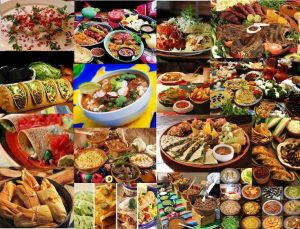
Step 3:
Usando la comida de su collage, van a decir el nombre que se usa aquí en los estados unidos sobre la comida o el plato y después vas a decirnos como le dices tu a esa comida.
| Nombre de la comida/plato en EE. UU | Como le dices tu |
| Ex. Cornflakes | Confleis (en Mexico) |
| Ex. Pastel | Torta (en Argentina) |
Step 4:
Traigan su collage para la siguiente clase y también la tabla con el nombre de su comida y como les dicen. Van a compartir su collage con un compañero y luego van a rotar para poder compartir lo que encontraron con mas estudiantes.
Actividad 2.4 : Chicano Songs
Step 1: In this activity students will be able to use You tube to search up some of the different Chicano songs and explore their different meanings and backgrounds.
Example : Strawberry Fields Forever By La Santa Cecilia
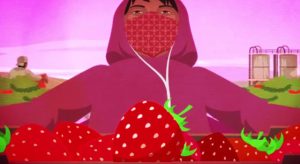 This song was originally made by The Beatles in 1967. The band La Santa Cecilia later in 2014 released this tribute cover song to Mexican migrant workers and the hard work they exude in the fields to nourish others and provide a decent life for their families.
This song was originally made by The Beatles in 1967. The band La Santa Cecilia later in 2014 released this tribute cover song to Mexican migrant workers and the hard work they exude in the fields to nourish others and provide a decent life for their families.
Actividad: Match location with produce
Bibliografia
Anzaldúa, Gloria. “How to tame A wild tongue.” The Border Reader, 2023, pp. 628–638, https://doi.org/10.1215/9781478027195-026.
Benavides , Karola. Food Collage. Sept. 2013. Mexican Food Recipes – Pinterest, https://www.pinterest.com.mx/pin/271623421248954570/. Accessed 8 Dec. 2023.
Boyle, Molly. “‘The Power Is in Your Body’: The Activism of Dolores Huerta.” Santa Fe New Mexican, 29 Sept. 2017, www.santafenewmexican.com/pasatiempo/the-power-is-in-your-body-the-activism-of-dolores-huerta/article_4a3dab3e-72f0-5d39-9248-edd56a196c9c.html.
“Can You Find Your Identity Through A Heritage-Language?” YouTube, YouTube, 26 Nov. 2019, https://www.youtube.com/watch?v=s5fJ3z0WQ_8. Accessed 9 Dec. 2023.
Chicano Eats. (n.d.). Chicano eats. https://chicanoeats.com/
LaSantaCeciliaVEVO. (2014, August 4). La Santa Cecilia – Strawberry Fields Forever [Video]. YouTube. https://www.youtube.com/watch?v=nkNv5Y1_Q4c
Luisa, Parra Velasco María. Enseñanza Del Español y Juventud Latina. Arco Libros, 2021.
“Solicitud”. El Eco de Cuba, July 20, 1855, Readex, Accessed 9 Dec. 2023.
“Solicitudes”. La Prensa, August 16, 1916, Readex, Accessed 9 Dec. 2023.
“Thirty Years of Farmworker Struggle (U.S. National Park Service).” National Parks Service, U.S. Department of the Interior, www.nps.gov/articles/000/a-new-era-of-farm-worker-organizing.htm. Accessed 9 Dec. 2023.
“UFW History.” UFW, ufw.org/research/history/ufw-history/. Accessed 9 Dec. 2023.
